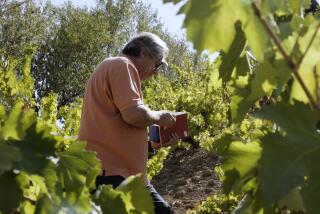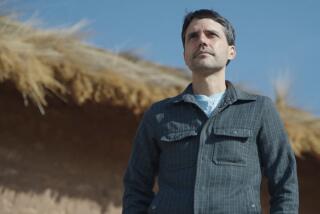Brewery May Serve Up Pre-Columbian Mysteries
- Share via
In an announcement that bears the slight ring of a bad Super Bowl commercial, a group of anthropologists have described an ancient mountaintop brewery where wealthy, beautiful maidens brewed beer for extravagant parties, serving their libations in 64-ounce cups.
The brewery serviced the earliest known diplomatic embassy in the Americas, a palace complex atop a steep-sided mesa in southern Peru built by the Wari empire around 600 B.C. When the empire collapsed 400 years later, residents of the mountaintop abandoned the place -- but not before holding a final, blowout feast and burning down the brewery, smashing ceremonial cups in the flames.
Discovery of the brewery may offer insights into mysteries shrouding advanced pre-Columbian civilizations living along South America’s Andean mountain chain, said Patrick Ryan Williams, anthropology curator for the Field Museum in Chicago.
“The output of the brewery probably was intended for massive feasts, but we wanted to know for whom the feasts were held, who held them and for what reasons,” Williams said. He and his wife, an adjunct professor at the University of Illinois at Chicago, are among the co-authors of a paper on the excavations published this month in the Proceedings of the National Academy of Sciences.
The Wari empire and its southern rival, the Tiwanaku empire, were the precursors to the better-known Inca empire, Williams said. Although the two empires flowered side-by-side, each raised food in radically different ways and had distinct traditions of art, architecture and governance. For reasons unknown, both empires fell and disappeared at the same time, about 1000 B.C.
Archeologists would like to know more about their synchronous history and the fact that two powerful, expansive neighbors apparently lived for 400 years in non-warlike harmony.
The new paper is “extremely important,” said Joyce Marcus, a University of Michigan archeologist who was not involved in the research. Marcus called it “a ‘case study’ of the rise and fall of two expansionist empires that coexisted for a substantial amount of time, apparently without either empire succeeding in dominating the other.”
Scientists also hope to gain insight into the origins of the Inca empire, the most powerful in the Americas until destroyed in the 1500s by Spanish conquistadors.
“A lot of Inca culture, such as its traditions of feasting and feting visiting officials, local officials and so on, was probably drawn from these earlier cultures, including the central role drinking beer had in these rituals,” Williams said. “The Incas chose their most beautiful royal women from all over the empire to perform ritual work like brewing beer and weaving the finest cloth for the fabulous robes that connoted status to those who wore them.”
Archeologists working in the Wari mountaintop outpost, called Cerro Baul, think they found something similar when excavating last year.
“In Incan and pre-Incan societies, we know only women of high status or nobility were allowed to wear special metal shawl pins to hold their garments together,” said Donna Nash, Williams’ wife. “When we excavated the brewery site in Cerro Baul, we found these pins all over the place, but not many elsewhere in the complex.”
Cerro Baul, which was discovered in 1980, is a remarkable, almost inaccessible, archeological site atop sheer walls that rise abruptly 2,000 feet above one of the driest areas in the world.
Conditions seem to have been the same when the expanding Wari empire installed a small but elaborate royal town of 2,000 people atop the mountain.
“They implanted a city on top of the mesa, a place where there was no water source that we can detect, and no arable areas for growing food,” Williams said. “All the food and water used in the city had to be carried up treacherous trails for 400 years on the backs of humans and llamas. The timber, mortar, paving stones and other building materials had to be hauled up that way too.
“It is very difficult for us to get up there, an hour hike along steep, narrow little trails, so we camp there during our excavations.”
Excavations of palaces, temples, artisan workshops and peasant quarters on the 15-acre mountaintop are done under the direction of former Field curator Michael E. Moseley, now a University of Florida anthropology professor who is the lead author of the article.
Putting the town atop the hard-to-reach summit gave the Wari a defensible citadel and conferred prestige among locals who considered the mountain sacred, the authors said. It also showed rivals that the Wari had the power, wealth and ability to settle such an economically impractical site.
Foremost among those they wanted to impress were the Tiwanaku people, who had built a sizable city, Chen Chen, four miles south of Cerro Baul.
The two empires had a common border hundreds of miles long north of Lake Titicaca, the world’s highest navigable lake, in present-day Bolivia. Each developed ingenious, irrigated food-growing technologies to mitigate against their mountainous, arid lands.
A 60-mile buffer separated the two empires along the border except at Cerro Baul, where Wari nobles regularly welcomed and hosted official delegations from Tiwanaku, Williams said.
The beer-making damsels at the brewery, Nash said, were probably selected for their beauty and for the status of their families. They probably also wove the elaborate, colorful robes worn by the ruling elite at such parties, garments that reflected the wearer’s status.
The beer was fermented from corn mash -- making a potent concoction called chicha that is still brewed in the Andes today -- and spiced with peppercorn tree berries.
“This was no mini-brewery operation,” Williams said. “It was the biggest early brewery anyone has so far seen. The brewing facility had three main areas: a grinding room for corn, a boiling room with at least 20 huge vats that allowed them to brew 1,000 to 2,000 liters of beer at a time, and a storage area with huge, 4-foot-high clay storage vessels.”
That meant every five or six days the brewery could turn out at least 500 gallons.
At official functions, it was served in seven distinct sets of beautiful drinking vessels made from clay, narrow at the bottom, flaring up to much wider tops. Some held 64 ounces.
The beer accompanied sumptuous feasts in Cerro Baul’s opulent palace featuring roasted deer, llama and alpaca as well as delicacies not available to commoners of the realm, including fish brought from the distant Pacific Ocean, condor, pygmy owls, puma and guinea pig.
The partying went on for generations until the two empires fell apart. Nobody knows the cause, perhaps an as yet undetected ecological disaster. Williams said it was as if there was a sudden “crisis in faith” among commoners, who began ignoring the centralized governments and retreated to smaller fortified villages.
The ruins at Cerro Baul show that it was deliberately and quickly abandoned after elites ceremoniously burned the palace and other buildings.
The last to be burned was the brewery. Sifting through the ruins last year, Williams said, it looked as if attendees to the last party stayed on to drink the brewery’s final batch of chicha, then torched the building.
The summit has not been occupied since, he said.
More to Read
Sign up for Essential California
The most important California stories and recommendations in your inbox every morning.
You may occasionally receive promotional content from the Los Angeles Times.










